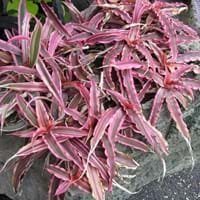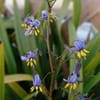Life Span
Perennial
Perennial
Type
Tender Perennial
Herbaceous Perennial
Origin
North America, Mexico, Latin America and the Caribbean, Caribbean, Central America, South America
Hybrid origin
Types
Not Available
Not Available
Habitat
Lowland evergreen rainforest, Rainforest, Shaded sites, Wild
meadows, Riverbanks, Rocky Mountains
USDA Hardiness Zone
Not Available
5-9
AHS Heat Zone
Not Available
9-5
Sunset Zone
Not Available
2b, 3a, 3b, 4, 5, 6, 7, 8, 9, 10, 11, 12, 13, 14, 15, 16, 17, 18, 19, 20, 21, 22, 23, 24
Habit
Not Available
Clump-Forming
Minimum Height
Not Available
Minimum Width
Not Available
Flower Color
Not Available
White, Yellow, Blue, Purple, Orange, Pink, Rose, Coral, Peach, Burgundy, Lavender, Plum, Orange Red, Dark Salmon, Bronze, Chocolate, Black
Flower Color Modifier
Bicolor
Bicolor
Fruit Color
Not Available
Not Available
Leaf Color in Spring
Not Available
Green, Light Green, Gray Green
Leaf Color in Summer
Not Available
Yellow green
Leaf Color in Fall
Not Available
Not Available
Leaf Color in Winter
Light Green
Light Green
Leaf Shape
Linear
Sword-like
Plant Season
Spring, Summer, Fall, Winter
Spring
Sunlight
Not Available
Full Sun, Partial Sun
Growth Rate
Not Available
Medium
Type of Soil
Not Available
Clay, Loam, Sand
The pH of Soil
Not Available
Acidic, Neutral, Alkaline
Soil Drainage
Not Available
Well drained
Bloom Time
Not Available
Early Spring, Spring, Late Spring
Repeat Bloomer
Not Available
No
Tolerances
Drought
Drought
Where to Plant?
Container, Ground, Pot
Ground
How to Plant?
Cuttings, Leaf Cutting, Seedlings
Root Plants
Plant Maintenance
Medium
Medium
Watering Requirements
Average Water Needs, Do not water excessively, Keep the Soil well drained
Average Water Needs
In Summer
Lots of watering
Lots of watering
In Spring
Moderate
Moderate
In Winter
Average Water
Average Water
Soil pH
Not Available
Acidic, Neutral, Alkaline
Soil Type
Not Available
Clay, Loam, Sand
Soil Drainage Capacity
Not Available
Well drained
Sun Exposure
Not Available
Full Sun, Partial Sun
Pruning
Remove damaged leaves, Remove dead branches, Remove dead leaves
Remove damaged leaves, Remove dead branches, Remove dead leaves
Fertilizers
All-Purpose Liquid Fertilizer
All-Purpose Liquid Fertilizer
Pests and Diseases
Pests and diseases free, Red blotch
Bacteria, fungus, Viruses
Plant Tolerance
Drought
Drought
Flower Petal Number
Single
Single
Showy Fruit
Not Available
No
Edible Fruit
Not Available
No
Fragrant Flower
Not Available
Yes
Fragrant Fruit
Not Available
No
Fragrant Leaf
Not Available
No
Fragrant Bark/Stem
Not Available
No
Showy Foliage
Not Available
No
Showy Bark
Not Available
No
Foliage Texture
Not Available
Fine
Foliage Sheen
Not Available
Matte
Self-Sowing
Not Available
No
Attracts
Ladybug beetles, Mealybugs, Scale Insects
Butterflies, Hummingbirds
Allergy
Not Available
Not Available
Aesthetic Uses
Beautification, Borders, Decorating walls, Ground Cover
Beautification, Showy Purposes
Beauty Benefits
Not Available
Not Available
Environmental Uses
Air purification
Air purification
Medicinal Uses
Not Available
Not Available
Part of Plant Used
Not Available
Flowers, Root
Other Uses
Used as Ornamental plant, useful as a ground cover
Basketary, Used for fragrance
Used As Indoor Plant
Yes
No
Used As Outdoor Plant
Yes
Yes
Garden Design
Not Available
Cutflower, Foundation, Mixed Border, Rock Garden, Wall
Botanical Name
CRYPTANTHUS 'Ocean Mist'
IRIS 'Apollo'
Common Name
Hybrid Cryptanthus
Carmen Iris, Dutch Iris
In Hindi
Hybrid Cryptanthus
Dutch Iris
In German
Hybrid Cryptanthus
Dutch Iris
In French
Hybrid Cryptanthus
Dutch Iris
In Spanish
Hybrid Cryptanthus
Dutch Iris
In Greek
Hybrid Cryptanthus
Dutch Iris
In Portuguese
Hybrid Cryptanthus
Dutch Iris
In Polish
Skrytokwiat
Dutch Iris
In Latin
Hybrid Cryptanthus
Dutch Iris
Phylum
Magnoliophyta
Magnoliophyta
Class
Liliopsida
Magnoliopsida
Family
Bromeliaceae
Iridaceae
Clade
Angiosperms, Commelinids, Monocots
Angiosperms, Monocots
Tribe
Not Available
Irideae
Subfamily
Not Available
Iridoideae
Importance of Hybrid Cryptanthus and Dutch Iris
Want to have the most appropriate plant for your garden? You might want to know the importance of Hybrid Cryptanthus and Dutch Iris. Basically, these two plants vary in many aspects. Compare Hybrid Cryptanthus and Dutch Iris as they differ in many characteristics such as their life, care, benefits, facts, etc. Every gardener must at least have the slightest clue about the plants he wants to plant in his garden. Compare their benefits, which differ in many ways like facts and uses. The medicinal use of Hybrid Cryptanthus is Not Available whereas of Dutch Iris is Not Available. Hybrid Cryptanthus has beauty benefits as follows: Not Available while Dutch Iris has beauty benefits as follows: Not Available.
Compare Facts of Hybrid Cryptanthus vs Dutch Iris
How to choose the best garden plant for your garden depending upon its facts? Here garden plant comparison will help you to solve this query. Compare the facts of Hybrid Cryptanthus vs Dutch Iris and know which one to choose. As garden plants have benefits and other uses, allergy is also a major drawback of plants for some people. Allergic reactions of Hybrid Cryptanthus are Not Available whereas of Dutch Iris have Not Available respectively. Having a fruit bearing plant in your garden can be a plus point of your garden. Hybrid Cryptanthus has no showy fruits and Dutch Iris has no showy fruits. Also Hybrid Cryptanthus is not flowering and Dutch Iris is flowering. You can compare Hybrid Cryptanthus and Dutch Iris facts and facts of other plants too.





